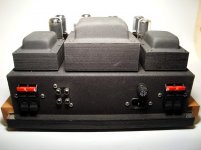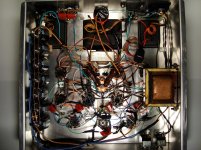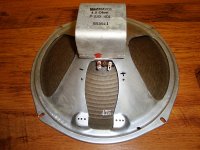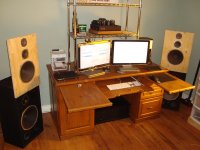Hey guys, just a general question for you.
I have a 6v6 PPP amp in my avatar that I built. I was fortunate enough to have Lance Cochrane himself supervise on this build
I noticed that on some bass heavy tracks, the upper and mids get quieter with big bass hits. Should I cut back the feedback a little bit?
I can supply technical information about my amp if needed. Just a general question wondering if that is a symptom of too much feedback.
I have over 1000uf as second PS cap, so it's not for lack of power reserve, I mean the amp will play for over 10 seconds after I switch the power off. lol
I suppose I could ask Lance, just figured this would be a little quicker. Fall is here so I am getting the soldering iron out to tinker.
I have a 6v6 PPP amp in my avatar that I built. I was fortunate enough to have Lance Cochrane himself supervise on this build
I noticed that on some bass heavy tracks, the upper and mids get quieter with big bass hits. Should I cut back the feedback a little bit?
I can supply technical information about my amp if needed. Just a general question wondering if that is a symptom of too much feedback.
I have over 1000uf as second PS cap, so it's not for lack of power reserve, I mean the amp will play for over 10 seconds after I switch the power off. lol
I suppose I could ask Lance, just figured this would be a little quicker. Fall is here so I am getting the soldering iron out to tinker.
The bass frequencies require the most output power.
I'm guessing that the amplifier is clipping. As the clipping occurs, the mids and highs (which essentually are riding atop the heavy bass) are the first to disappear.
Reducing the playback volume might be the solution. I doubt that feedback is the issue.
I'm guessing that the amplifier is clipping. As the clipping occurs, the mids and highs (which essentually are riding atop the heavy bass) are the first to disappear.
Reducing the playback volume might be the solution. I doubt that feedback is the issue.
... remembering some stuff from the MJ books, if the final stage is cathode-biased with bypass caps, large caps can lead to a bias shift in large signal peaks, which can take up to several 100ms for the final stage bias to recover to normal levels.
It's only a theoretical thought, but if this happens with a bass peak, following mids and highs might be affected by that.
Greetings,
Andreas
It's only a theoretical thought, but if this happens with a bass peak, following mids and highs might be affected by that.
Greetings,
Andreas
Trying to keep this short is difficult as there is so much bearing on sound quality.I noticed that on some bass heavy tracks, the upper and mids get quieter with big bass hits. Should I cut back the feedback a little bit?
I can supply technical information about my amp if needed. Just a general question wondering if that is a symptom of too much feedback.
One can cut the global feedback down but the fault remains in a lesser form of undesirable intermodulation at the expense of higher thd and noise depending on the leeway of the design, it will always be there unless a drastic circuit review is done: The original 3 stage Mullard 20W amp; the Williamsons suffered from oversized coupling caps; and my Linear Concord 50Watt which uses a sim LTP 3 stage design as per Mullard 20W, all suffered badly from bass transient overhang which modulated the midrange, esp on classics and worse when the bass control was wound up to +18dB or more. Once noticed, one becomes very distracted by it. It can also be a symptom of gross bass overload on a poorly sized output transformer.
The problem could also be a slack power supply not able to supply the current or most likely, too high interstage cap values. Need a schematic on this.
The technical side is complex, nasty and to many boring. There is circuit damping theory associated with a phase locked loop response, which is essentially what global nfb is doing; closing the loop on the stable side solong the values keep within the Bode plot regards octave decay and cutoff response as tampering with the global nfb loop also changes the circuit Q factor.
In my 150-200W amps I address this problem by selecting careful values of the concertina p/s caps by using a very low frequency pulse 1Hz or lower squarewave at a very low level and observing transient circuit overhang...if the scope has an Y output used as a wobbulator then even better.
Once a compromise value is selected, a full-pull test accompanied by a hefty beatnote reveals perfect reproduction of two tones.
In each and every case in push pull circuits I find that the optimum bass overhang/transient response occurs when the f2 distortion is around 1.4% at the LF design cutoff frequency of the output transformer. With other circuits, not the case. The bigger the amp design, the more important the issues become as overhang sucks unnecessary power rides and increased tube dissipation. Big issues.
There are more snags; another subject.....Thought about the loudspeaker ? Got an undersized cheapo box, versus the amp power ? On the instance of a hefty beat note with maximum cone excursion forced against the stops, it's obvious the cone is furthest away from the magnet. That would immediately give the same modulation result one is hearing in the midrange. This is where large cabinets with large speaker frames rule the room. What's next ? the influence with Crossover networks.
I find the selecting the correct circuit capacitors is far more responsive to reducing the problem you outlined.
Sorry for being so long, but having experienced the these problems on a commercial side some 45 yrs ago, the issues deserve an airing.
I hope MJ's new book 4th ed which is due to come out, has some relevance on this.
richy
I guess richwalters is a better help here - my knowledge of valve technology is limited to the MJ books, one half-finished test setup of an all-valve PP1C and the basics that I have from studying physics and working on UHV experiments...
Greetings,
Andreas
PS. Will of course continue to read here - maybe this will also become important for my project - hope I'll ever find the time to continue with that...
Greetings,
Andreas
PS. Will of course continue to read here - maybe this will also become important for my project - hope I'll ever find the time to continue with that...
MJ books are one of many references...we all refresh from. The Radiotron handbook 4th ed which is one of my old trade favourites covers some of the issues in chapter 7.
Sometime ago I did some graphs of coupling cap values versus closed loop transient responses in Williamson 4 stage amps which show the circuit problems. I will find them.
richy
Sometime ago I did some graphs of coupling cap values versus closed loop transient responses in Williamson 4 stage amps which show the circuit problems. I will find them.
richy
No need to be sorry, thanks for that.
I will draw up some schematics and post it on here, I should have a set anyways, they are Magnovox 142's.
I am going to play around with the speakers because I have a very oddball setup.
12" Jensens in open baffle, 2 3" GE tweeters/mids (One receives fulls range sound while the other is crossed -overed.
Below that I am using 8" Sansui woofers in their SPX-4000 boxes.
I have it wired in a way to increase the bass at the 8"woofers. When I first hooked it up the 12"ers were too loud (sensitive). Part of the reason for this is my amp has 3-4ohm taps.
The Sansui's really move, full excursion for sure. Maybe that "mid" that's taking the full range has something to do with it too, it's identical to the tweeter, just no cap.
So I will play with some speakers and report back with any results.
Here are some pictures of my amp if you want to have a look in the meantime.
The inverters were replaced with 6CG7s also an extra 6CG7 stage was added as a bit of a pre, I was told would make it sound more musical. Truthfully it's too loud. Before I added the extra stage it was dead-nuts silent, now it pics up a bit of computer noise, nothing major, but it was silent before. I can't turn things up very much, my computer volume is at 1, sometimes I "crank" it to 15, this is out of 100!
I will draw up some schematics and post it on here, I should have a set anyways, they are Magnovox 142's.
I am going to play around with the speakers because I have a very oddball setup.
12" Jensens in open baffle, 2 3" GE tweeters/mids (One receives fulls range sound while the other is crossed -overed.
Below that I am using 8" Sansui woofers in their SPX-4000 boxes.
I have it wired in a way to increase the bass at the 8"woofers. When I first hooked it up the 12"ers were too loud (sensitive). Part of the reason for this is my amp has 3-4ohm taps.
The Sansui's really move, full excursion for sure. Maybe that "mid" that's taking the full range has something to do with it too, it's identical to the tweeter, just no cap.
So I will play with some speakers and report back with any results.
Here are some pictures of my amp if you want to have a look in the meantime.
The inverters were replaced with 6CG7s also an extra 6CG7 stage was added as a bit of a pre, I was told would make it sound more musical. Truthfully it's too loud. Before I added the extra stage it was dead-nuts silent, now it pics up a bit of computer noise, nothing major, but it was silent before. I can't turn things up very much, my computer volume is at 1, sometimes I "crank" it to 15, this is out of 100!
Attachments
I don't know now, maybe I'm making too much of it, I guess we will see after you have a peek at the drawings. When I turn the volume up a little and give er some gas , I can't seem to notice it now.
I played some different songs at low volume, seemed to be noticeable on certain tracks.
The one song in particular was Benny Bennassi's "Satisfaction", in my defense I downloaded it after hearing it on a new episode of Beavis and Buthead. It's a neat tune.
I played some different songs at low volume, seemed to be noticeable on certain tracks.
The one song in particular was Benny Bennassi's "Satisfaction", in my defense I downloaded it after hearing it on a new episode of Beavis and Buthead. It's a neat tune.
I did try the different Dolby settings in windows media player, can't turn them off there.
I am using the EQ in iTunes and have the Sound Check enabled, not the enhancer though.
I suppose the Sound Check might be doing something. It makes all the songs the same over all volume. Not sure how it does it though, could be compressing.
I will try it tomorrow and see, too late to play tonight.
I will try it with my iPad in the AM.
AL
I am using the EQ in iTunes and have the Sound Check enabled, not the enhancer though.
I suppose the Sound Check might be doing something. It makes all the songs the same over all volume. Not sure how it does it though, could be compressing.
I will try it tomorrow and see, too late to play tonight.
I will try it with my iPad in the AM.
AL
Ya seems in the EQ.
The EQ kills the "airness" in general. I had not really played with the speakers since I built the amp. I EQ'ed it a bit to remove some of the "shout" from the 12" Jensen's in open baffle. Like I said it's a odd-ball speaker setup. I'm playing around with a few things.
I just assumed the EQ would just or raise the frequency etc. but it seems to be more complex then that.
I've been doing some other reading on iTunes "Sound Check", the option that apparently adjusts all your songs volume level, does have an effect on quality too.
I also will add my previous experience with the preamp slider in the EQ, it also introduces distortion if raised at all. Just like a guitar amp, lol.
So this got me off my but to setup some speakers. lol I will not be using ANY sound options at all, except I am stuck with Dolby on Windows Media Player.
Thanks for your Help.
I will post some schematics in another thread for any that are interested. I'm playing around drawing the schematics in Google Sketchup.
The other programs are not as intuitive to me as Sketchup, so I thought it would quicker. Al
The EQ kills the "airness" in general. I had not really played with the speakers since I built the amp. I EQ'ed it a bit to remove some of the "shout" from the 12" Jensen's in open baffle. Like I said it's a odd-ball speaker setup. I'm playing around with a few things.
I just assumed the EQ would just or raise the frequency etc. but it seems to be more complex then that.
I've been doing some other reading on iTunes "Sound Check", the option that apparently adjusts all your songs volume level, does have an effect on quality too.
I also will add my previous experience with the preamp slider in the EQ, it also introduces distortion if raised at all. Just like a guitar amp, lol.
So this got me off my but to setup some speakers. lol I will not be using ANY sound options at all, except I am stuck with Dolby on Windows Media Player.
Thanks for your Help.
I will post some schematics in another thread for any that are interested. I'm playing around drawing the schematics in Google Sketchup.
The other programs are not as intuitive to me as Sketchup, so I thought it would quicker. Al
SUCCESS!! I was playing around with speaker setups today. I was having a problem getting it just right. Just for the heck of it I decided to check the polarity of all the speakers I was testing. Wouldn't you know it, The polarity was marked backwards on the 12" Magnavox/Jensens! No wonder I was noticing something strange related to the bass hit. The 12" open baffle was out of phase with the 8" Sansui in the ported box, and the other speakers.
So heres the setup now. I tried those black speakers you see in the picture below. They sounded like complete garbage. I did how ever mount the 12" Maggies in there.
Up top in the open baffle, I settled on a 10" pair of Jensens. Above that is a 4" Mid and a 3" Tweeter(Tesla) Everything is AlNico, the Mid and Tweeter have curved horn shaped cones.(Not Flat).
It was a discovery moment for sure, it sounded good before(heavily EQed) but it sounds absolutely AMAZING now. Goosebumps all over.
Obviously the bass has improved dramatically, going from 8" to 12" woofers, the 10"s sound great in the baffles, nothing forced about it. I really don't need the EQ, it sounds pretty flat (for a slapped together setup), although I did raise the bass a little for listening at quiet volume levels.
So heres the setup now. I tried those black speakers you see in the picture below. They sounded like complete garbage. I did how ever mount the 12" Maggies in there.
Up top in the open baffle, I settled on a 10" pair of Jensens. Above that is a 4" Mid and a 3" Tweeter(Tesla) Everything is AlNico, the Mid and Tweeter have curved horn shaped cones.(Not Flat).
It was a discovery moment for sure, it sounded good before(heavily EQed) but it sounds absolutely AMAZING now. Goosebumps all over.
Obviously the bass has improved dramatically, going from 8" to 12" woofers, the 10"s sound great in the baffles, nothing forced about it. I really don't need the EQ, it sounds pretty flat (for a slapped together setup), although I did raise the bass a little for listening at quiet volume levels.
Attachments
If you're applying gain with digital EQ then you will almost always end up with some sort of compression occurring at some point.
The signal level cannot exceed 0dBfs, so if you've applied 5dB of gain at 100Hz and along comes a piece of music that has 100Hz content at -2dB, then you're going to get compression occurring as the EQ program will either
1) Scale everything back by 3dB, so the 5 extra can still be applied - this will result in the sound getting subjectively quieter albeit very briefly.
2) Compress the 5dB boost down to only 2dB to prevent clipping - this will not affect the overall level of the sound.
3) Do nothing to prevent the signal level from exceeding 0dBfs and thus create digital clipping which sounds horrible.
Most Equalisers will have the option to normalise the levels, in which case say you apply 5dB at 100Hz, it will scale everything back by 5dB so that the 5dB of gain at 100Hz now sits at 0dBfs and everything else is at -5. Obviously if in doubt you can do this yourself by turning every other slider on the parametric equaliser down by 5dB instead of turning the 100Hz slider up by 5.
The signal level cannot exceed 0dBfs, so if you've applied 5dB of gain at 100Hz and along comes a piece of music that has 100Hz content at -2dB, then you're going to get compression occurring as the EQ program will either
1) Scale everything back by 3dB, so the 5 extra can still be applied - this will result in the sound getting subjectively quieter albeit very briefly.
2) Compress the 5dB boost down to only 2dB to prevent clipping - this will not affect the overall level of the sound.
3) Do nothing to prevent the signal level from exceeding 0dBfs and thus create digital clipping which sounds horrible.
Most Equalisers will have the option to normalise the levels, in which case say you apply 5dB at 100Hz, it will scale everything back by 5dB so that the 5dB of gain at 100Hz now sits at 0dBfs and everything else is at -5. Obviously if in doubt you can do this yourself by turning every other slider on the parametric equaliser down by 5dB instead of turning the 100Hz slider up by 5.
- Status
- This old topic is closed. If you want to reopen this topic, contact a moderator using the "Report Post" button.
- Home
- Amplifiers
- Tubes / Valves
- Too much feedback?




